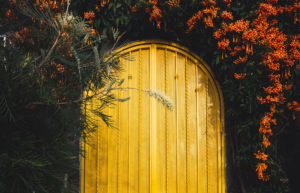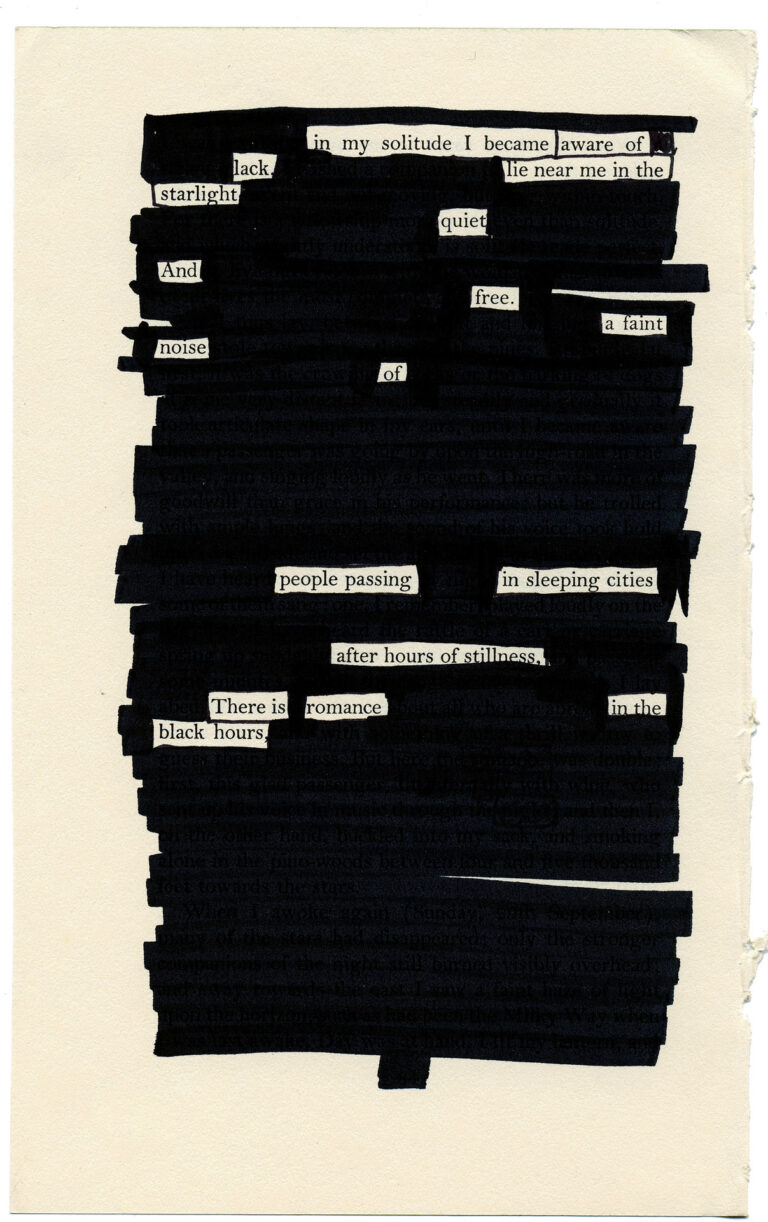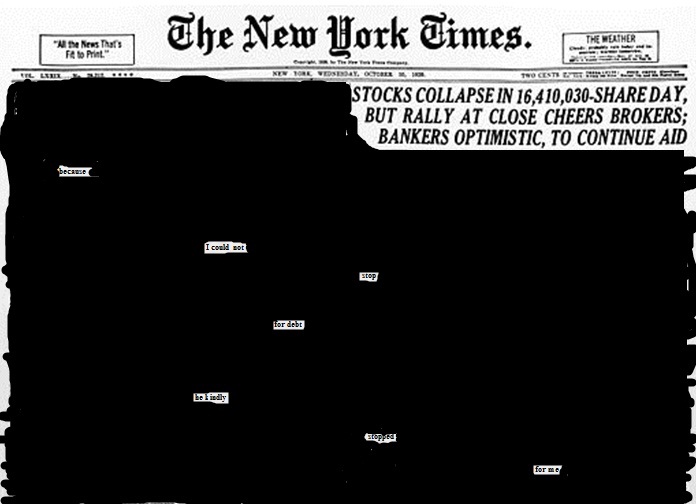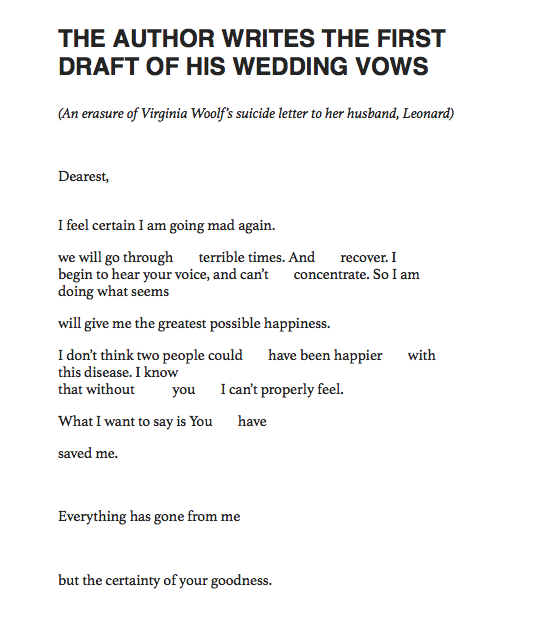If you struggle to find the right words, why not start with somebody else’s? Such is the philosophy behind blackout poetry, a recent artistic and literary phenomenon that has blossomed in the past decade.
What is blackout poetry? Chances are, you have already seen blackout poetry in action: maybe it’s shown up on your social media timeline, or maybe you’ve read The New York Times’ Searching for Poetry series. Blackout poetry pages are easy to create, share, and celebrate, so it’s no wonder that their prominence coincided with the rise of social media.
The internet is populated with blackout poetry examples, and we’d like to share some of our favorites—while also explaining how to do blackout poetry. Let’s explore this artsy and inventive poetry form.
What is Blackout Poetry: Contents
What is Blackout Poetry? A Brief History of the Form
Like most things in literature, blackout poetry—also known as erasure poetry, redacted poetry, and a form of found poetry—has a complex history.
In fact, the earliest known blackout poetry examples hail from Benjamin Franklin’s days. Ben’s neighbor, Caleb Whiteford, would publish redacted versions of the paper, using puns flowing across the text to create new meaning in the pages. You can learn more about Whiteford in this TEDxKC talk with Austin Kleon.
Now, Whiteford was ahead of his time. This creative play with physical text would not resurface until the Dada movement (1915-1925), in which artists expressed surreal, absurd, and existential thoughts through the interplay of words and images. This interplay, commonly known as collaging, reignited a love for the physical play with language, encouraging poets to experiment with form and language simultaneously.
The Dadaists, the Beat Poets, and other 20th century movements continued to explore and expand the form, but blackout poetry earned its greatest support from Austin Kleon at The New York Times. In 2010, Austin Kleon published his collection Newspaper Blackout; an instant bestseller, Newspaper Blackout (alongside Kleon’s Tumblr and Instagram presence) put blackout poetry pages in front of every writer’s screen.
From the New York Times’ interactive generator to Outrun the Stigma’s erasure poetry community project, blackout poetry continues to enjoy its digital popularity.
Before we dive into how to do blackout poetry, let’s look at and examine some blackout poetry examples, including the original texts those poems used.
Article continues below…
Poetry Writing Courses We Think You'll Love
We've hand-picked these courses to help you flourish as a writer.

Get Inspired!: Poems and Poets to Light Up Your Writing
Write new poetry inspired by US historical poets and poets laureate, while immersing yourself in poetry to transform your writing...
Find Out More
Opening the Door to Poetry
How do we use poetry to express life's marvelous complexity? Learn how to control language beyond the "ordinary" and discover...
Find Out MoreOr click below to view all courses.
See CoursesArticle continues…
Blackout Poetry Examples and Analysis
Great blackout poetry can be short or long, abstract or concrete, linear or lateral. There’s only one rule of the form: have fun making it!
Well-crafted blackout poetry pages give new meanings to old texts, and the interplay of those texts often creates new and surprising meanings. Here are three poems that accomplish that goal.
Note: the third poem is an example of erasure poetry, not blackout poetry, but we include this in our examples list as the two forms accomplish something similar.
1. Blackout Poetry by Tyler Knott Gregson
“In my solitude
I became aware of
lack.
Lie near me
in the starlight, quiet
and free.
A faint noise
of people passing in
sleeping cities
after hours of stillness.
There is romance
in the black
hours.”
Source Text: Travels with a Donkey in the Cevénnes by Robert Louis Stevenson (Chapter 10).
Analysis: There’s a wonderful simplicity to this blackout poem. It’s central images are starlight, sleeping cities, and the night; these images build upon each other a romantic notion of the quiet dark, subverting a general notion of romance as bright and energetic.
Additionally, the poem’s source text is a memoir about Stevenson’s journey through the wild as he distanced himself from a recent love affair. With this context, the poem’s natural imagery becomes both somber and hopeful, reinforcing the poem’s implications about love.
In other words, the blackout poem helps modernize the themes of Stevenson’s memoir, while also using imagery to suggest something short and bittersweet about love. The two texts work wonderfully both as separate entities and as an intertextual dialogue.
2. Blackout Poetry by Anonymous, misquoting Emily Dickinson
“Because I could not stop for debt, he kindly stopped for me.”
Source Text: Headline from the New York Times announcing the 1929 stock market crash.
Analysis: This poem is an intentional misquotation of Emily Dickinson’s line “because I could not stop for death, he kindly stopped for me.” The blackout poem itself is a strong critique of the Great Depression, which happened partially because investors were borrowing money to buy stocks, and could not repay their debts after a speculative bust in the market.
History books aside, there’s a lot of fun intertextuality with this poem. By substituting “death” for “debt” and blacking out a New York Times article, the poem can be interpreted as a critique of both speculative investing and the role journalism played in amplifying the crash.
3. Erasure Poetry: The Author Writes the First Draft of his Wedding Vows by Hanif Willis-Abdurraqib
From The Crown Ain’t Worth Much.
“Dearest,
I feel certain I am going mad again.
we will go through terrible times. And recover. I
begin to hear your voice, and can’t concentrate. So I am
doing what seems
will give me the greatest possible happiness.
I don’t think two people could have been happier with
this disease. I know
that without you I can’t properly feel.
What I want to say is You have
saved me.
Everything has gone from me
but the certainty of your goodness.”
Source Text: Virginia Woolf’s suicide letter to her husband, Leonard.
Analysis: each word of this erasure poem is carefully selected, and each word holds a stunning amount of grief, irony, love, and madness. Hanif has preserved the most emotional parts of Woolf’s letter while also assembling those parts into something new: a poem that is saved by the madness of love.
How to Do Blackout Poetry: A Step-by-Step Approach
Funny or poignant, carefree or politically charged, any text can be turned into a blackout poem. You might see artsy and colorful blackout poetry examples on Pinterest, but all you need for blackout poetry is a marker.
Armed with your writing utensil of choice, you can make blackout poetry pages in four steps:
- Identify the text you want to blackout.
- Draw boxes over meaningful words, images, phrases, and ideas.
- Draw an image outline or arrows for reading the text, if necessary.
- Color it in!
1. Identifying a Source Text
Not all blackout poems have a relationship to their source text, but the best blackout poetry often carries a dialogue with its source. As the author Annie Dillard notes, the meaning of a text “now swings between two poles” in the making of blackout poems, creating a kind of visual dialectic.
Many blackout poetry examples use literary sources—the three examples we chose were from a book, newspaper, and letter, respectively. You might also find poetry inspiration from books, poems, essays, news stories, or letters that deeply impact you.
At the same time, most texts are valid options for blackout poems. Be as conventional or esoteric as you’d like: you can blackout recipes, driving manuals, national constitutions, cereal box ingredient lists, toaster oven instructions, wikipedia pages, etc.
2. Boxing Key Words and Phrases
Blackout poetry is a process of narrowing down the words you don’t want, then selecting and arranging the words that are left. As such, the first thing you should do with your marker is draw boxes around the words you want to keep.
Of course, you can box a word in the beginning and cross it out later. The important part is to narrow your source text into a few key images and ideas.
Take Tyler Knott Gregson’s poem, the first of our blackout poetry examples. About half of the boxed words are nouns and verbs, many of which develop concrete images. “Solitude” and “romance” are the only conceptual nouns, and they’re sprinkled between images of starlight, sleeping cities, and black hours.
It’s also important to identify comparison words. “Like” and “as” will help compare different ideas in the text, so don’t black them out until you’re sure you don’t need them.
Finally, if a word or phrase jumps out as striking, beautiful, or meaningful, save it. You may decide it doesn’t fit into the poem later, but oftentimes, blackout poetry is built around language that was already beautiful in the source text.
3. Make Connections (Optional)
Once you’ve blacked out the words you want your poem to use, take a moment to consider how the poem is read. Can the poem be read linearly, from left to right? Or do you want certain words to connect in different directions?
If the words should be read out of order, consider leaving white space to demonstrate reading order. This is not a requirement of blackout poetry, but it is something to consider.
4. Color it in!
Once you’ve chosen the words you need, cross out the rest. There’s no wrong way to color, so channel your inner five year old and get scribbling!
Where Can I Share My Blackout Poetry Pages?
Much of blackout poetry’s newfound success lies in social media. Twitter, Pinterest, Tumblr, and Instagram each have a lot of poems uploaded under their #blackoutpoetry or #newspaperblackout tags, with poets all around the world participating. Share your poetry there, too!
Unfortunately, blackout poetry publications are few and far between. There used to be a journal dedicated solely to the form, but Found Poetry Review sadly ceased operations in 2016. More mainstream journals are beginning to accept blackout submissions, but the form is most prominent in digital communities and social media hashtags.
It’s never bad practice to share your blackout poems on social media. This kind of visual content can help you stay connected with interested readers, and if you’re lucky, your writing might gain attention with a lot of re/tweets/blogs/pins/posts. Social media engagement is a simple way to keep up with the business of writing, so use blackout poetry as both a creative and productive opportunity!
Discover More Ways to Write Poetry at Writers.com
Blackout poetry is a great way to expand your writing toolkit. If you’re looking for more ways to create visual poetry or boost your creativity, look no further than our upcoming course schedule.





Really appreciate this l never studied poetry formally but your article has enlarged my writing horizon. We will keep in touch l am a Creative Writer and will be working with young adults in a church circuit. When l finally am exployed we will certainly do business.
Thanks a million l will spread the good news about you.
I’m so happy to hear that, Carol! Thanks very much for your comment, I’m wishing you great luck on your writing journey
Very good! 😀
Thank you I found the writing and exmples illuminating!
[…] a club remix showing a change in genre and form. But it can also apply to other mediums, such as black-out poetry and photo […]
[…] of your book, you could use its pieces to do some arts and crafts. You can use some pages to do blackout poetry, or you can cut out some words and use them to create collages. You also can glue things onto the […]
This article helped me a lot! My grandson DMed me asking if I know how to make blackout poetry and I was like “what the?” Lol! I had to research to learn so I can help him with his assignment. We didn’t have blackout poetry back in 1980s (or maybe I was absent?) lol! Thanks again!
I love this and is very smart since I’m a person of poetry myself and I never knew that black poetry was a thing until now I know this will also help my poetry hobby improve in a few little ways.
[…] I had a student tell me how much she loves the Blackout Poetry stuff I put out. She said, “I got a page and it was about a baby dying, and I had no idea how […]
[…] What is blackout poetry? It’s the process of redacting text to create an entirely new poem. Find blackout poetry examples and ideas here. — Read on writers.com/what-is-blackout-poetry-examples-and-inspiration […]
[…] Many teachers teach poetry, and I mentioned the science teacher who was very open to our haiga project. I have had students in the library doing book spine poems the last couple of years. Teachers also like doing blackout poetry. […]
The word ‘revolver’ in the 2nd version of the Virginia erasure poem above, shouldn’t that be ‘recover’?
[…] Blackout poetry has been around for years. To me, it feels modern, but was first recorded in the 18th Century where Benjamin Franklin’s neighbour published redacted versions of newspapers. Then of course there’s Tom Phillip’s A Humument (short for Human Document, a ‘treated’ Victorian novel) published in 1970; not only a book-length poem but a work of art. You can read about the history of what we call blackout poetry here. […]
[…] Blackout Poetry – Blackout poetry eliminates portions of text. The left behind words are what create the poem. […]
[…] խորհուրդներ եւ խորհրդանիշներ։ Ապա Ասատուրեան վարեց blackout poetry-ի աշխատանոց մը, որուն ընթացքին ուսանողները պարտէին […]
[…] in these works, and wanted to draw on these similarities in this project. I was also inspired by blackout or erasure poetry, in which the poet removes words or phrases from another’s work to create a new work. An […]
this was very helpful ty
I really enjoyed this informational article. Sean the author should be really proud of his work one of the best articles I have read.
I just discovered this medium from a new bookstore in our area. They regularly stick a bunch of them on their store windows. Wanted to find out more & came across your article, thanks for the great examples, I’m inspired to take on my first project now!
[…] Writers.com have a great page defining Blackout Poetry for anyone who is unfamiliar. In a nutshell, it is simply an exercise in taking an existing piece of text and identifying words within it to make your own poem. In my case, each week I’m going to take one of the books I’m reading, photocopy the double-page spread my bookmark is currently on, and make something from that. The result may not make sense, and certainly won’t be as polished or taken as seriously as my normal work, but it’ll force me to consider subjects, ideas, and words that I probably wouldn’t place in my own work. I think it’ll create some really interesting pieces! […]
[…] Writers.com have a great page defining Blackout Poetry for anyone who is unfamiliar. In a nutshell, it is simply an exercise in taking an existing piece of text and identifying words within it to make your own poem. In my case, each week I’m going to take one of the books I’m reading, photocopy the double-page spread my bookmark is currently on, and make something from that. The result may not make sense, and certainly won’t be as polished or taken as seriously as my normal work, but it’ll force me to consider subjects, ideas, and words that I probably wouldn’t place in my own work. I think it’ll create some really interesting pieces! […]
[…] Writers.com have a great page defining Blackout Poetry for anyone who is unfamiliar. In a nutshell, it is simply an exercise in taking an existing piece of text and identifying words within it to make your own poem. In my case, each week I’m going to take one of the books I’m reading, photocopy the double-page spread my bookmark is currently on, and make something from that. The result may not make sense, and certainly won’t be as polished or taken as seriously as my normal work, but it’ll force me to consider subjects, ideas, and words that I probably wouldn’t place in my own work. I think it’ll create some really interesting pieces! […]
It’s very interesting! I will try to write a Blackout Poetry about The Phantom of The Opera as my homework!
[…] Writers.com have a great page defining Blackout Poetry for anyone who is unfamiliar. In a nutshell, it is simply an exercise in taking an existing piece of text and identifying words within it to make your own poem. In my case, each week I’m going to take one of the books I’m reading, photocopy the double-page spread my bookmark is currently on, and make something from that. The result may not make sense, and certainly won’t be as polished or taken as seriously as my normal work, but it’ll force me to consider subjects, ideas, and words that I probably wouldn’t place in my own work. I think it’ll create some really interesting pieces! […]
[…] Writers.com have a great page defining Blackout Poetry for anyone who is unfamiliar. In a nutshell, it is simply an exercise in taking an existing piece of text and identifying words within it to make your own poem. In my case, each week I’m going to take one of the books I’m reading, photocopy the double-page spread my bookmark is currently on, and make something from that. The result may not make sense, and certainly won’t be as polished or taken as seriously as my normal work, but it’ll force me to consider subjects, ideas, and words that I probably wouldn’t place in my own work. I think it’ll create some really interesting pieces! […]
So true and so emotional without much hard work best poetry lol
I’ll try to write one about the Outsiders for homework!